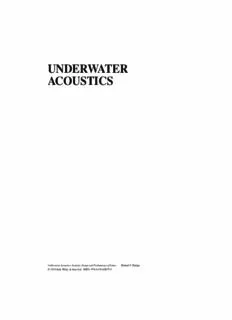Table Of ContentP1:OTE/OTE/SPH P2:OTE
FM BLBK275-Hodges April8,2010 15:15 PrinterName:YettoCome
UNDERWATER
ACOUSTICS
Underwater Acoustics: Analysis, Design and Performance of Sonar Richard P. Hodges
© 2010 John Wiley & Sons Ltd. ISBN: 978-0-470-68875-5
P1:OTE/OTE/SPH P2:OTE
FM BLBK275-Hodges April8,2010 15:15 PrinterName:YettoCome
UNDERWATER
ACOUSTICS
ANALYSIS, DESIGN AND
PERFORMANCE OF SONAR
RichardP.Hodges
Sonalysts,Inc.
A John Wiley and Sons, Ltd., Publication
P1:OTE/OTE/SPH P2:OTE
FM BLBK275-Hodges April8,2010 15:15 PrinterName:YettoCome
Thiseditionfirstpublished2010
(cid:1)C 2010JohnWiley&Sons,Ltd
Registeredoffice
JohnWiley&SonsLtd,TheAtrium,SouthernGate,Chichester,WestSussex,PO198SQ,UnitedKingdom
Fordetailsofourglobaleditorialoffices,forcustomerservicesandforinformationabouthowtoapplyforpermissionto
reusethecopyrightmaterialinthisbookpleaseseeourwebsiteatwww.wiley.com.
TherightoftheauthortobeidentifiedastheauthorofthisworkhasbeenassertedinaccordancewiththeCopyright,
DesignsandPatentsAct1988.
Allrightsreserved.Nopartofthispublicationmaybereproduced,storedinaretrievalsystem,ortransmitted,inanyform
orbyanymeans,electronic,mechanical,photocopying,recordingorotherwise,exceptaspermittedbytheUKCopyright,
DesignsandPatentsAct1988,withoutthepriorpermissionofthepublisher.
Wileyalsopublishesitsbooksinavarietyofelectronicformats.Somecontentthatappearsinprintmaynotbeavailablein
electronicbooks.
Designationsusedbycompaniestodistinguishtheirproductsareoftenclaimedastrademarks.Allbrandnamesand
productnamesusedinthisbookaretradenames,servicemarks,trademarksorregisteredtrademarksoftheirrespective
owners.Thepublisherisnotassociatedwithanyproductorvendormentionedinthisbook.Thispublicationisdesignedto
provideaccurateandauthoritativeinformationinregardtothesubjectmattercovered.Itissoldontheunderstandingthat
thepublisherisnotengagedinrenderingprofessionalservices.Ifprofessionaladviceorotherexpertassistanceisrequired,
theservicesofacompetentprofessionalshouldbesought.
LibraryofCongressCataloging-in-PublicationData
Hodges,RichardP.
Underwateracoustics:analysis,design,andperformanceofsonar/byRichardP.Hodges.
p.cm.
Includesindex.
ISBN978-0-470-68875-5(cloth)
1.Underwateracoustics. 2.Sonar–Mathematicalmodels. 3.Elasticwavepropagation. I.Title.
QC242.2.H632010
621.389’5–dc22
2010003321
AcataloguerecordforthisbookisavailablefromtheBritishLibrary.
ISBN 978-0-470-68875-5
Typesetin10/12ptTimesbyAptaraInc.,NewDelhi,India
PrintedinSingaporebyMarkonoPrintMediaPteLtd
P1:OTE/OTE/SPH P2:OTE
FM BLBK275-Hodges April8,2010 15:15 PrinterName:YettoCome
Contents
AbouttheAuthor xiii
Preface xv
Acknowledgements xvii
1 IntroductiontoSonar 1
1.1 AcousticWaves 1
1.1.1 CompressionsandRarefactions 3
1.2 SpeedofPropagation 4
1.3 AcousticWaveParameters 5
1.4 DopplerShift 9
1.5 Intensity,SPL,andDecibels 10
1.6 CombiningAcousticWaves 11
1.7 ComparativeParameterforSoundinWaterandAir 14
References 15
2 TheSonarEquations 17
2.1 Signal-to-NoiseRatio 17
2.2 ActiveSonarEquation 18
2.3 SignalExcess 20
2.4 FigureofMerit 20
References 21
3 Transducers,Directionality,andArrays 23
3.1 TransducerResponse 25
3.2 BeamPatternResponse 25
3.3 LinearArrays 27
3.3.1 TripletTowedArray 33
3.3.2 MultilineTowedArrays 33
3.4 RectangularPlanarArray 33
3.5 AmplitudeShading 37
3.6 ContinuousArrays 37
3.7 VolumetricArrays 41
3.8 ProductTheorem 44
P1:OTE/OTE/SPH P2:OTE
FM BLBK275-Hodges April8,2010 15:15 PrinterName:YettoCome
vi Contents
3.9 BroadbandBeamPatterns 45
3.10 DirectivityandArrayGain 45
3.11 NoiseCross-CorrelationbetweenHydrophones 47
3.12 DirectivityofLineArrays 49
3.13 DirectivityofAreaArrays 51
3.14 DirectivityofVolumetricArrays 52
3.15 DifferenceArrays 54
3.16 MultiplicativeArrays 57
3.17 SparselyPopulatedArrays 59
3.18 AdaptiveBeamforming 60
References 62
4 ActiveSonarSources 63
4.1 SourceLevel 63
4.2 Cavitation 64
4.3 Near-FieldInteractions 67
4.4 ExplosiveSources 67
4.5 PhysicsofShockWavesinWater 68
4.6 BubblePulses 72
4.7 ProsandConsofExplosiveCharges 73
4.8 ParametricAcousticSources 73
References 74
5 TransmissionLoss 75
5.1 SoundSpeedProfileintheSea 76
5.2 Snell’sLawandTransmissionacrossanInterface 77
5.3 ReflectionandTransmissionCoefficients 79
5.4 TransmissionthroughaPlate 82
5.5 RayTracing 84
5.6 SpreadingLoss 91
5.7 AbsorptionofSoundintheOcean 92
5.7.1 MechanismsofAbsorption 92
References 95
6 TransmissionLoss:InteractionwithBoundaries 97
6.1 SeaState,WindSpeed,andWaveHeight 97
6.2 Pierson–MoskowitzModelforFullyDevelopedSeas 99
6.3 SeaSurfaceInteraction 101
6.3.1 LloydMirrorInterference 101
6.3.2 LossDuetoInteractionwiththeSurface 104
6.4 BottomLoss 112
6.4.1 SimpleRayleighBottomLossModel 113
6.4.2 U.S.NavyOAMLApprovedModelsofBottomLoss 113
6.4.3 Low-FrequencyBottomLoss(LFBL)Model:50to1000Hz 113
6.4.4 High-FrequencyBottomLoss(HFBL)Model 114
6.4.5 High-FrequencyEnvironmentAcoustic(HFEVA)Model 117
P1:OTE/OTE/SPH P2:OTE
FM BLBK275-Hodges April8,2010 15:15 PrinterName:YettoCome
Contents vii
6.5 LeakageOutofaDuct,Low-FrequencyCutoff 117
6.6 PropagationLossModelDescriptions 120
6.6.1 RayModels 120
6.6.2 NormalModes 121
6.6.3 ParabolicEquations 122
6.6.4 U.S.NavyStandardModels 123
References 125
7 AmbientNoise 127
7.1 AmbientNoiseModels 127
7.2 SeismicNoise 128
7.3 OceanTurbulence 130
7.4 ShippingNoise 131
7.5 WaveNoise 131
7.6 ThermalNoise 131
7.7 RainNoise 131
7.8 TemporalVariabilityofAmbientNoise 133
7.9 DepthEffectsonNoise 133
7.10 DirectionalityofNoise 133
7.11 UnderIceNoise 137
7.12 SpatialCoherenceofAmbientNoise 138
References 140
8 Reverberation 143
8.1 Scattering,BackscatteringStrength,andTargetStrength 143
8.1.1 SurfaceandBottomScattering 143
8.1.2 VolumeScattering 152
8.1.3 BottomScattering 152
8.1.4 ReverberationTargetStrength 153
8.1.5 CalculationofReverberationforUseintheSonarEquation 154
8.1.6 VolumeReverberationLevel 156
8.2 ReverberationFrequencySpreadandDopplerGainPotential 157
8.2.1 PowerSpectralDensityofaCWPulse 159
8.2.2 EnvironmentalFrequencySpreading 161
8.2.3 FrequencySpreadingDuetoTransmitterandReceiverMotion 161
8.2.4 FrequencySpreadingDuetoTarget 162
8.3 ImportantObservationwithRespecttoReverberation 164
References 164
9 ActiveTargetStrength 167
9.1 TargetStrengthDefinition 167
9.2 ActiveTargetStrengthofaLargeSphere 169
9.3 ActiveTargetStrengthofaVerySmallSphere 170
9.4 TargetStrengthsofSimpleGeometricForms 173
9.5 TargetStrengthofSubmarines 173
9.6 TheTAPModel 174
P1:OTE/OTE/SPH P2:OTE
FM BLBK275-Hodges April8,2010 15:15 PrinterName:YettoCome
viii Contents
9.7 TargetStrengthofSurfaceShips 176
9.8 TargetStrengthofMinesandTorpedoes 176
9.9 TargetStrengthofFish 178
References 181
10 RadiatedNoise 183
10.1 GeneralCharacteristicsofShipRadiatedNoise 183
10.2 PropellerRadiatedNoise 184
10.3 MachineryNoise 186
10.4 ResonanceNoise 187
10.5 HydrodynamicNoise 187
10.6 PlatformQuieting 189
10.7 TotalRadiatedNoise 189
Reference 192
11 SelfNoise 193
11.1 FlowNoise 193
11.2 TurbulentNoiseCoherence 198
11.3 StrummingNoise 199
References 199
12 StatisticalDetectionTheory 201
12.1 Introduction 201
12.2 Case1:SignalIsKnownExactly 205
12.2.1 ObservationsonCase1 210
12.3 Case2:SignalIsWhiteGaussianNoise 210
12.3.1 ObservationsonCase2 213
References 214
13 MethodologyforCalculationoftheRecognitionDifferential 215
13.1 ContinuousBroadbandSignals(PBB) 216
13.1.1 PBBStep1:TheoreticalBroadbandNrd 217
13.1.2 PBBStep2:CorrectionforNoiseSpectrum 217
13.1.3 PBBStep3:CorrectionforProcessorImplementation 220
13.1.4 PBBStep4:CorrectionforNonidealSignalCharacteristics 226
13.1.5 PBBStep5:AdjustmentforAdditionalAt-SeaLosses 227
13.2 ContinuousNarrowbandSignals(PNB) 227
13.2.1 PNBStep1:TheoreticalNarrowbandNrd 229
13.2.2 PNBStep2:CorrectionforNoiseSpectrum 230
13.2.3 PNBStep3:CorrectionforProcessorImplementation 233
13.2.4 PNBStep4:CorrectionforNonidealSignalCharacteristics
(SignalIsNotaPerfectSineWave) 239
13.2.5 PNBStep5:AdjustmentforAdditionalAt-SeaLosses 240
13.2.6 NrdCalculationExample 241
P1:OTE/OTE/SPH P2:OTE
FM BLBK275-Hodges April8,2010 15:15 PrinterName:YettoCome
Contents ix
13.3 ActiveSonar 241
13.3.1 CWActivePulseActiveStep1:TheoreticalNrd 242
13.3.2 ActiveStep2:CorrectionforNoiseSpectrum 253
13.3.3 ActiveStep3:CorrectionforProcessorImplementation 255
13.3.4 ActiveStep4:CorrectionforNonidealSignalCharacteristics 257
13.3.5 ActiveStep5:AdjustmentforAdditionalAt-SeaLosses 257
13.3.6 NrdCalculationExamples 258
13.4 AuralDetection 258
13.5 DisplayNomenclature 261
References 264
14 FalseAlarms,FalseContacts,andFalseTargets 265
14.1 SeaStory 265
14.2 FailuretoDetect 266
14.3 DetectionTheory 266
14.3.1 HypothesisTesting 266
14.3.2 ProbabilityDensityFunction 267
14.3.3 DetectionofConstantLevel 268
14.4 FalseAlarmProbabilityCalculation 269
14.5 False/NonthreatContacts 271
14.6 FalseTargets 271
14.7 SummaryandConclusions 272
References 272
15 VariabilityandUncertainty 273
15.1 RandomVariabilityofaSonar 276
15.2 SourcesofVariability 276
References 281
16 ModelingDetectionandTacticalDecisionAids 283
16.1 FigureofMeritRangeorR50% 283
16.2 TacticalDecisionAids 287
References 289
17 CumulativeProbabilityofDetection 291
17.1 WhyisCPDImportant? 291
17.2 DiscreteGlimpseandContinuousLooking 291
17.3 Lambda–SigmaJumpModel 292
17.4 NonjumpProcesses 293
17.5 WhatAreAppropriateRandomParameters? 293
17.6 ApproximationMethodforComputationoftheCumulativeProbability
ofDetection(CPD) 296
References 298
P1:OTE/OTE/SPH P2:OTE
FM BLBK275-Hodges April8,2010 15:15 PrinterName:YettoCome
x Contents
18 Tracking,TargetMotionAnalysis,andLocalization 299
18.1 BearingTrackers 299
18.1.1 AmplitudeDifferenceMethod 299
18.1.2 PhaseDifferenceMethodorCross-CorrelationMethod 300
18.2 GeneralPrincipleofTrackingandBearingMeasurement 301
18.3 OtherSourcesofBearingErrorforAreaArrays 303
18.4 AdditionalSourcesofErrorsforLineArrays 305
18.5 BottomBounce 306
18.6 ManualversusAutomaticTracking 306
18.7 LocalizationandTargetMotionAnalysis 307
18.7.1 Localization 307
18.7.2 WaveFrontCurvatureRanging(WFCR) 312
18.7.3 MultipathRanging(MPR) 314
18.7.4 Depression/Elevation(D/E)Ranging 317
18.7.5 TriangulationRanging 317
18.8 BearingsOnlyMethodologies 319
18.9 Four-BearingTMA 319
18.10 EkelundRanging 321
18.11 RangeandBearingTMA 322
18.12 OtherBearingsOnlyTMAMethodologies 323
18.13 OtherTMAandLocalizationSchemes 324
References 324
19 DesignandEvaluationofSonars 325
19.1 ChoiceofFrequencyandSize 325
19.2 ComputationalRequirements 327
19.2.1 Beamforming 328
19.3 SignalProcessingafterBeamformer 329
19.3.1 Detection 329
19.4 ActivePulseChoice 330
19.5 Monostatic,Bistatic,andMultistaticActiveSonars 332
19.6 AmbiguityFunctions 334
19.7 MineHuntingandBottomSurveySonars 334
19.8 EchoSoundingandFishingSonars 335
19.9 Navigation 336
19.10 VehicleLocationandAt-SeaRescue 336
19.11 InterceptReceivers 336
19.12 Communications 336
19.13 MarineMammalsandActiveSonar 337
References 337
A FourierTransforms 339
A.1 Definitions 339
A.2 Parseval’sTheoremandPlancherel’sTheorem 340
A.3 PropertiesofFourierTransforms 341
A.4 LocalizationorUncertaintyProperty 341
P1:OTE/OTE/SPH P2:OTE
FM BLBK275-Hodges April8,2010 15:15 PrinterName:YettoCome
Contents xi
B AnalysisofErrorsAssociatedwithaLeastSquaresMethodology 343
Reference 346
Index 347
Description:Offering complete and comprehensive coverage of modern sonar spectrum system analysis, Underwater Acoustics: Analysis, Design and Performance of Sonar provides a state-of-the-art introduction to the subject and has been carefully structured to offer a much-needed update to the classic text by Urick.

